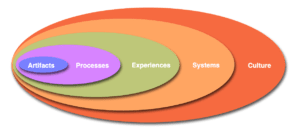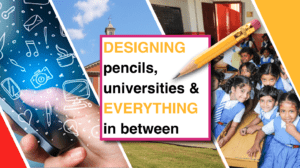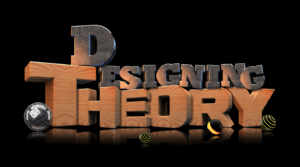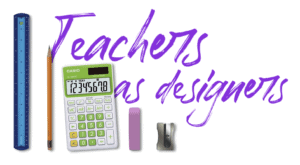Research: Education by Design
The idea of design

Design is core to my identity, to who I am. Education is the space within which I function but I try to approach everything I do as a designer.
Herb Simon, in his book, The Sciences of the Artificial, famously wrote:
Everyone designs who devises courses of action aimed at changing existing situations into preferred ones.
In one fell swoop, Simon situated design as playing a role across a range of human-centered professions, whether it be graphic design, architecture, medicine, or social policy.
And most relevant to us: Education.
Which is why I prefer to call myself an educational designer (rather than educational researcher). I see the world through the lens of design. Everything in the world around me, education, parenting, research, to me are enriched by taking on this perspective: a design lens as it were.
It is no surprise, thus, that one of my favorite courses I teach is called Education by Design. The course intro is as follows:
DCI 691 (Education by Design) is a course about design. Design as a way of thinking and as a process that values collaboration, context, and diverse perspectives. Design as an approach that generates creative solutions to complex (wicked) problems of practice, particularly in education.
Design is both a noun and a verb, a product and a process. Design is central to the construction of any process or artifact—be it a website or a car; an ATM machine or educational policy. Design touches on many different disciplines—science, technology, engineering, education, psychology, sociology, organizational behavior, and art, to name a few. A multi-dimensional issue like design, particularly in education, requires a multifaceted approach.
for The 5 spaces for design in education

Everything in education is designed (one can argue whether this is intentional or not or whether the outcomes are the ones we want/like) but the broader point is that there is nothing “natural” about the systems of education we have around us. They are constructed by us, by humans. Whether the idea of the curriculum or seat-time, learning metrics or the idea of problem-based learning, or the idea of school, these are all human creations, structures adapted for some purpose (to quote Perkins and his definition of design).
That said, there is something fundamentally different about designing a textbook v.s. a chair; or designing a school v.s. designing an instructional plan. The differences have as much to do with the scale and the complexity of the tasks as it has to do with human psychology i.e. people’s desires and needs. That is not all. Everything we do in education works within broader organizational, policy and information structures that constrain and guide what we can do, and the complex feedback loops that can emerge from the inherent complexity (wickedness) of the enterprise. What this means is that designers have to function differently depending on the “space” they are working within.
In our recent work, Melissa Warr and I, have been developing a framework that we are calling the Five Spaces for Design in Education. In brief, we argue that it may be productive to think of five spaces for the design in education: artifacts, processes, experiences, systems and culture. Moreover, working within these spaces requires different tools, elements, practices, knowledge and judgement that we as designers need to bring to the task.
The best introduction to the FIve Spaces Framework is a series of videos made for ASU’s Learning Sparks series. You can find all the videos here: 6 videos (on the 5 spaces for design in education
In addition Melissa Warr maintains a page on the talkingaboutdesign.com website that lists all the publications/presentations that have emerged from this line of work.
My journey through design

I was invited to give a keynote at the 50th Anniversary of the Industrial Design Center. It was here at IDC that I was introduced to the idea of design—something that I did not know much about before, but something I seemed to fit right into. I took this as an opportunity to look back over my journey through design and education. You can read more about it – and watch the video here.
Designing Theory

Theories play a critical role in the development of a discipline. Theories allow us to understand, explain and predict phenomena in the world. That said it is often difficult to say just where theories come from. The standard model—that data lead to laws, that in turn lead to theories—has been undermined by philosophers of science for a while now. They argue, and I would suggest rightly, that theories are often under-determined by data, i.e. there is never enough data that will, inevitably, lead us to a particular theory. This situation is particularly problematic given the important role theories play in scholarly lives.
In Warr, Scragg & Mishra (2020) we argue that it may be productive to see the development of theory as being akin to a process of design —that of creating an artifact (albeit a conceptual one) that has “a structure adapted to a purpose” and demonstrates “goodness of fit. We argue that, viewing theory development as an act of design might lead to a stronger theoretical and practical scholarship and can help us address some key challenges in the field.
Teachers as Designers

What does it mean for a teacher to be described as a designer, or for the act of teaching to be considered an act of design?
The paper cited below is a synthesis of 10 years of educational research into the idea that it is productive to see educators as designers—as designers of curriculum, designers of learning experiences. We analyzed citation patterns of key journal articles to (a) identify emergent clusters or strands of work; and (b) the manner in which the roles teachers play as designers varies across time.
Warr, M., Mishra, P. (2021). Integrating the discourse on teachers and design: An analysis of 10 years of scholarship. Teaching and Teacher Education. https://doi.org/10.1016/j.tate.2020.103274
Abstract: This article presents a content and network analysis of a decade (2007 – 2017) of highly-cited literature on teachers and design. Constructs and definitions were compared in an interpretive content analysis, resulting in 10 strands, each a cluster of literature that frames teaching and design in a particular way. A citation network analysis provided insight into how the strands are conceptually related. Further analysis highlighted how each strand described what, when, and how teachers design, and the value of considering teachers as designers. The results suggest that teaching not only includes design activities, but could be considered a design profession. This perspective has implications for teacher education, specifically the development of professional knowledge.
More here.
Blog posts related to Design
Metaphors, Minds, Technology & Learning
Note: The shared blogging experiment with Melissa Warr and Nicole Oster continues. This time we delve into metaphors of the mind, technology and generative AI. The core idea and first draft came from Melissa, to which I contributed a substantial rewrite. The final...
Who speaks for the university? Social fiction as a lens for reimagining higher education futures
Note: Image above created using Adobe Firefly, Photoshop and composed in Keynote. A few years ago, I had the pleasure of connecting with author Dr. Phoebe Wagner through the Center for Science and the Imagination at Arizona State University. We discussed her...
Why are we surprised? Hallucinations, bias and the need for teaching with and about genAI
By Punya Mishra, Melissa Warr & Nicole Oster Note: This is the first post in an experiment at shared blogging by Melissa Warr, Nicole Oster and myself. Over the past months we have found ourselves engaged in some fascinating conversations around genAI, education,...
SITE 2024: A recap
The Society for Information Technology in Teacher Education (SITE) conference has been an integral part of my professional journey for over two decades. My first presentation at SITE was back in 2001 with Matt Koehler and through the years, SITE has played a pivotal...
AI in Education: Potentials, Perils & Policies
NORRAG, based at the Geneva Graduate Institute, is a global network focused on international education policy and cooperation, known for its commitment to addressing under-researched topics related to education quality and equity and amplifying voices from the Global...
The (Neil) Postman Always Rings Twice: 5 Questions on AI and Education
Note: This post has also been cross-posted on the Civics of Technology blog. Marie Heath (with whom I recently co-wrote a blog post about GenAI in Teacher Education: A techno-skeptical perspective) and I were invited to write a chapter for an edited volume titled...
Creative dialogue with Generative AI: Exploring the Possible with Ron Beghetto
As part of our ongoing series for the journal TechTrends exploring the intersections of technology, education, and creativity, we have recently turned our focus to the potential impacts of generative AI (GenAI) on these domains. Our latest article features a...
Generative AI in Education: Keynote at UofM-Flint
A couple of weeks ago I was invited to give a keynote at the Frances Willson Thompson Critical Issues Conference on Generative AI in Education. It was great to go back to Michigan even if for a super short trip. One of the pleasures of the visit was catching up with...
“Tipping” the Scales: When Metaphors (Quite Literally) Blur Reality
Should we tip machines for the work they do for us? Does that question even make sense? What follows is a reflection on metaphors, technology, deceptive design, AI and more... Read on. Metaphors and more In her book God, Human, Animal, Machine, Meghan O’Gieblyn...
Media, Cognition & Society through History: A Mapping
If oral cultures prioritize memory and print cultures emphasize systematic organization, what types of knowledge will AI systems foster? Marie Heath and I wrote this line in a chapter that is currently in press. But the idea underlying this quote has been with me for...
The Absurd One-Sidedness of the Ethics of AI Debate: A rant
It seems no conversation about AI and education is complete without discussing the importance of the ethical use of the technology. There are numerous reports and academic articles about it (this and this and this ... I could go on and on). There is, however, one...
Education & the Rise of AI Influencers
I have been thinking hard about the nature of generative AI, what sets it apart from other technologies that have come in the past. It seems to me there are two key factors. The first is its ability to engage in dialogue, in natural language and the second are its...
Reflection: Welcome 2024
Since December 2008 we have been creating a video to welcome the new year. When we made our first video we had no idea that we would still be doing it 16 years later, and, frankly who knows how long we can keep it up. These videos are usually typographical in nature,...
GenAI 2023: Year in Review
A week or so ago I was joined by friends Sean Leahy, Rachna Mathur and Kellie Kreiser on the Learning Futures Podcast. The topic: looking back on a crazy, dynamic, transformative year of generative AI. As is to be expected, we covered a lot of ground in the...
Me & We in AI
What does generative AI mean to me? And to us? These key questions were part of a special exhibit curated by students in the DCI 691: Education by Design course I taught this fall. Education by Design is my favorite class to teach. It is a course about design—design...
Punya Mishra
Associate Dean of Scholarship & Innovation
Professor, Division of Educational Leadership & Innovation
Mary Lou Fulton Teachers College
Arizona State University
Email: punya[dot]mishra[at]asu.edu
Web: punyamishra.com
LinkedIn: PunyaMishra
Twitter: @punyamishra
©
All the content (text, images, photographs, videos) on this site have been created by me, Punya Mishra, (unless specified otherwise). I would like to thank the artists/photographers/designers who have made their work freely available for re-use on sites such as Wikimedia Commons, Pixabay and Unsplash. Most of the graphics I create build on your generosity, and I am deeply grateful.
This website is designed and maintained by me, Punya Mishra, using WordPress combined the Divi plugin and is hosted on Cloudways.
